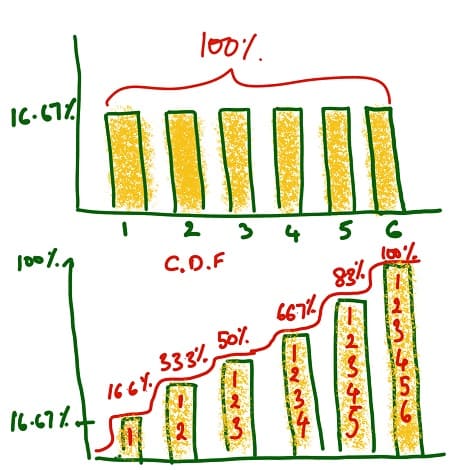
Cdf statistics pdf#
The reliability function, failure rate function, mean time function, and median life function can be determined directly from the pdf definition, or f(t)\,\!. In the previous sections, we used the definition of the pdf to show how all other functions most commonly used in reliability engineering and life data analysis can be derived. P(a\le X\le b)=\int_=0\ \,\!įor a continuous distribution, the mode is that value of t\,\! that corresponds to the maximum probability density (the value at which the pdf has its maximum value, or the peak of the curve).Ī statistical distribution is fully described by its pdf. If X\,\! is a continuous random variable, then the pdf of X\,\! is a function, f(x)\,\!, such that for any two numbers, a\,\! and b\,\! with a\le b\,\! : The pdf and cdf give a complete description of the probability distribution of a random variable. The cumulative distribution function, cdf, as F(x)\,\!.The probability density function, pdf, as f(x)\,\!.We will now take a closer look at these functions and how they relate to other reliability measures, such as the reliability function and failure rate.įrom probability and statistics, given a continuous random variable X,\,\! we denote:

When these functions are known, almost any other reliability measure of interest can be derived or obtained. The probability density function ( pdf) and cumulative distribution function ( cdf) are two of the most important statistical functions in reliability and are very closely related. The Probability Density Function and the Cumulative Distribution Function In this case, the variable is said to be a discrete random variable. That is, X\,\! is a random variable that can take on one of only two values (let's say defective = 0 and non-defective = 1). In judging a component to be defective or non-defective, only two outcomes are possible. In this reference, we will deal almost exclusively with continuous random variables. In this case, our random variable X\,\! is said to be a continuous random variable.

Our component can be found failed at any time after time 0 (e.g., at 12 hours or at 100 hours and so forth), thus X\,\! can take on any value in this range.

In the case of times-to-failure, our random variable X\,\! is the time-to-failure of the component and can take on an infinite number of possible values in a range from 0 to infinity (since we do not know the exact time a priori). We can then use a random variable X\,\! to denote these possible measures. In general, most problems in reliability engineering deal with quantitative measures, such as the time-to-failure of a component, or qualitative measures, such as whether a component is defective or non-defective.


 0 kommentar(er)
0 kommentar(er)
